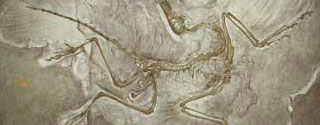
Discuss (Up to OJB's Religion and Science Page) Evolution: Evidence of Transitional FormsOne of the common points people mention when trying to discredit evolution is the lack of transitional forms in the fossil record. It is true that there are many missing transitional fossils or "missing links" but this isn't surprising because only a small part of one percent of animals ever become fossilised. In some ways it is surprising that so many transitional forms do exist. Its not necessary to discover every transitional fossil to show that species change, there is enough evidence to clearly show species changing form for certain types of animals (and plants). There is good evidence of the transition of fish to living on land and becoming amphibians. Eusthenopteron was a genus of lobe-finned fish which seems to have made the transition. It became extinct in the process, but gave rise to the first amphibians 360 million years ago. Ichthyostega had legs but its limbs probably weren't used for walking as once believed, but were used instead to negotiate its way through the swamps of the time. Recently, an amphibious creature that lived 375 million years ago was discovered. It has turned out to be a "missing link" in the emergence of the first fish-like animals to walk on land. The animal has characteristics of a primitive land animal, with limb-like appendages, a crocodilian head and tooth-filled jaws, but it still has scales, fins and gills. Temnospondyls, such as Pholidogaster were a group of large labrinthodont amphibians, and were a transitional form between the early and later amphibians. Perhaps the best example of a major transition is from theropod dinosaurs to birds. The evidence is sufficiently good that we can say that birds definitely evolved from dinosaurs. Intermediate forms have been discovered showing the evolution of bird-like features; such as feathers, pelvic bones, and muscle attachment. Archaeopteryx is the most famous example of a transition to birds, and contrary to some creationist comments, there are many fossil examples, not just one; the feathers are well defined, not imaginary; and they most definitely aren't fakes. Its the earliest and most primitive known bird. Ten specimens of Archaeopteryx have now been found in a limestone deposit near Solnhofen, Germany. In the 1990s, the discovery of a number of well-preserved feathered dinosaurs in China solidified the link between dinosaurs and birds. A further seven skeletons have come to light, and all of them confirm that it is a genuine link. Mammals evolved from therapsid dinosaurs and the transition forms are extensively preserved as fossils. Distinctive mammal features, such as the inner ear, skull, and teeth are well preserved in fossils. Advanced therapsid forms have many mammal-like attributes, including a skull intermediate in type between that of primitive reptiles and mammals. The tritylodont is a fossilised intermediate form from the late Triassic which has a skull with very mammalian features. Dimetrodon was a predatory synapsid (mammal-like "reptile") that flourished during the Permian period, about 260 million years ago. It is more closely related to mammals than to true reptiles, like dinosaurs, lizards and birds. The evolution of the whale from a land-based mammal to the modern whale is well understood. The whole process took only 15 million years and was basically complete by 40 million years ago. Fossil evidence shows changes in legs becoming flippers, ears changing, and breathing system changing. Fossil evidence exists from at least 4 different areas of the world. Ambulocetus is a fossil whale with legs which lived in the water and on land during the Eocene. The evolution of the modern horse is well understood. Mesohippus was a horse transitional form which lived about 25 to 40 million years ago. It had longer legs than its predecessor Hyracotherium and was about two feet tall. It had also lost a toe and stood mainly on its middle toe, although the other two were also used. The face was longer and larger than earlier equids. The skull and eye placement also became more like modern horses. Other modern species we have evidence of transitions in their evolution are Ursavus elmensis which was a small, heavy dog-like animal, intermediate between arctoids and bears. Another was Dinictis (early Oligocene) was transitional from early cats such as Proailurus to modern feline cats.We have a remarkable amount of evidence for human evolution. An early form was Proconsul africanus, a fruit-eating, arboreal quadruped probably ancestral to all the later apes and humans. It had a mosaic of ape-like and primitive features: an ape-like elbow, shoulder and feet; monkey-like wrist; and gibbon-like lumbar vertebrae. A species leading to current humans was Australopithecus which seems to be the common ancestor of the distinct group of hominids, now called Paranthropus, and most likely the genus Homo which includes modern humans. And so it goes on. Do some research and you will see there are hundreds of intermediate forms. Evolution did occur here, there is no doubt. Many more intermediate forms haven't been discovered but it doesn't matter, evolution in the forms that have been discovered is undeniable to anyone who is prepared to look at the real facts. DiscussionComment by OJB on 2006-07-17 at 23:08:06: Recently, I have found even more extensive lists of intermediate forms. The fact is that there are enough intermediate forms to satisfy anyone who is prepared to look at the subject without bias. Anyone who still thinks there are no "missing links" is just fooling themselves. There is no way the anti-evolutionists can still say these things and maintain any credibility. ![[Up]](../XuShared/Up2B.jpeg)
![[Comment]](../XuShared/Comment2B.jpeg)
Insert query failed: INSERT INTO log VALUES (NULL,1,'2025-12-25','070100','ReligionTransitional.html','XuOtherPhilosophy','216.73.216.208','Mozilla/5.0 AppleWebKit/537.36 (KHTML, like Gecko; compatible; ClaudeBot/1.0; +claudebot@a','');. |